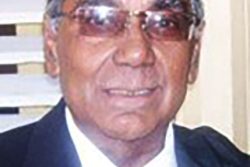WEST INDIES have again been jolted by the suspension of one of their major spinners, this time their most prominent.
As much to the point, Sunil Narine’s censuring by the umpires for a suspect action in successive matches for the Kolkata Knight Riders (KKK) in the Champions League that ended in Bengaluru yesterday is further evidence that the International Cricket Council (ICC) has finally grasped the game’s most agonizing nettle it had attempted for too long, albeit with good intentions, to handle with kid gloves.
It has changed its softly-softly approach to the burgeoning number of bowlers with flawed actions – in plain language, throwers, chuckers, pelters, stoners, call them what you will – and now encourages umpires to report those they deem to be transgressing.
Narine and Saeed Ajmal of Pakistan are the contemporary game’s most celebrated spinners. Ajmal is 10th among the ICC’s Test bowlers, tops in ODIs, fourth in T20s; Narine is second in both ODIs and T20s. They are superstars, in lucrative demand in the several Twenty20 tournaments across the globe.
They have both been cited, Ajmal in a Test against Sri Lanka in June, Narine at lower level in the Champions League. Since June, seven others of lesser standing have been reported for the same reason.
The unambiguous message is that the ICC will now rely more on the umpires’ judgment than the incalculable geometry of 15 degrees elbow flex, a system it first introduced into the equation in 2004, initially as a concession to the greatest of all the off-spin/doosra bowlers, the Sri Lankan wizard Muttiah Muralitheran.
The Pakistan board has quickly read its meaning correctly. It identified 28 bent-elbow bowlers – yes, 28 – in its recent domestic Twenty20 tournament, of whom 17 were off-spinners. Eight were immediately suspended so that they could have their actions straightened out before it’s too late.
The West Indies Cricket Board (WICB) and its various affiliates need to follow suit with equal swiftness, at all levels, from first-class to youth and club cricket.
It has before it a few of prime examples of bowlers whose actions were suspect from an early age and whose careers were either disrupted or ended as no meaningful attempt was made to correct them.
Narine himself, off-spinner Shane Shillingford and the strapping fast bowler Jermaine Lawson all entered first-class cricket with doubts over how they bowled; Shillingford, twice, and Lawson later faced suspension from the international game. Now Narine is in danger of the same penalty.
Shillingford was no-balled three times for throwing by international cricket’s most experienced umpire, the Jamaican Steve Bucknor, in his debut first-class match, aged 17; Narine needed remedial work after his first season. Lawson’s suspension halted what was a promising career after 13 Tests.
At least now the great Curtly Ambrose, West Indies’ bowling consultant, is working to tweak the actions of Ronsford Beaton, 22, and Ray Jordan, 20, presently the two most promising young fast bowlers in regional cricket.
Ajmal has enjoyed longer success than most at all levels. The revelation that his elbow extension during recent trials covering eight overs at the National Cricket Centre in Brisbane was, on average, an absurd 40 degrees begs the question as to how come he managed to pass an earlier examination and was free to play 35 Tests?
Another pertinent question is what logic determines that a bowler under suspicion can play on for one more match? As an example, in 2005 in the Caribbean, Shabbir Ahmed, a giant Pakistani who threw with real pace and menace, helped win a decisive Test with match figures of 8-129 before starting his suspension. It is a pattern often repeated.
Paul Grayson, head coach of Essex in the English county championship, made a similar point about Ajmal’a influence with Worcestershire in the season just ended. Ajmal’s 63 wickets were taken at 16.47 runs each; it was, Grayson contended, the difference in Worcestershire topping them for promotion to Division 1.
John Davison, now a coach with Australia Cricket but more familiar as the Canadian who blazed the fastest hundred against West Indies in the 2003 World Cup in South Africa, noted another negative aspect of the influence of bowlers testing the 15 degrees limit.
During a recent coaching stint in Sri Lanka, he estimated that 90 per cent of emerging bowlers, mostly off-spinners, have grown up copying their heroes and “are going to struggle to bowl with a legal action”.
This is not to stay that Narine, or Ajmal for that matter, will similarly struggle on return; it is just that they are likely to be less effective without the method that has made them so successful.
Since the Champions League is a domestic tournament, Narine’s sanction does not extend to West Indies series of five ODIs against India that starts in Kochi on Wednesday; before then, he is being sent to the ICC approved Cricket Centre in Chennai to start on the necessary corrective measures.
As far as West Indies Cricket Board (WICB) chief executive Michael Muirhead is concerned, it is up to the selectors’ to make the call on whether or not he should remain for the West Indies matches.
Whatever the decision, the outcome could determine his future, for West Indies but even more so in the Indian Premier League (IPL) where he has been by far the most influential bowler since signed on by the Knight Riders after catching their attention for the Trinidad and Tobago Red Force in the Champions League in 2010.
Will he be as attractive a buy at future auctions with the shadow of eagle-eyed umpires hanging over him?
Narine has the expected support of his West Indies team mates and from Knight Riders coach, the Australian Trevor Bayliss who describes him as a strong character with the upbeat attitude that he is “happy to work on anything that needs to be worked on.”
Judging by Narine’s calm on-field reaction to the pressure as the top bowler in the IPL, Bayliss’ assessment is well taken.
The ICC has made its belated move. Its affiliated boards, Narine, Ajmal and every affected player need to now respond accordingly.









